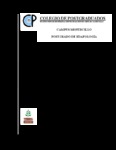Situación actual de producción y manejo del estiércol en el municipio de Texcoco
Abstract
Las unidades de producción bovino que generan volúmenes apreciables de estiércol en el municipio de Texcoco y cuyo manejo no es bueno, constituyen una fuente de contaminación, por pérdidas de nutrimentos. Es necesario Establecer regulaciones para reducir los efectos ambientales nocivos, por esta situación se requiere conocer la ubicación y situación actual de producción y manejo de los estiércoles en los plántales ganaderos del Municipio. la pérdida de los nutrimentos es mayor en los estiércoles frescos que son apilados por tiempos largos, que cuando se utilizan aditivos o se incorporan de manera inmediata al suelo. El presente trabajo evaluó, la situación actual de producción y manejo de los estiércoles; estableció la ubicación en el municipio de Texcoco de los principales centros productores de estiércol, se investigo el destino y uso, se implemento el manejo con aditivos (paja, suelo y una cubierta de plástico) para reducir la pérdida de nutrimentos. Para la investigación primero se hicieron una serie de encuestas en diferentes comunidades para ubicar las granjas con sistemas intensivos y de traspatio, y tener el número de animales existentes por cada unidad de producción y así estimar la cantidad de estiércol producido tanto en los sistemas intensivos como los sistemas de traspatio, se conoció el uso, manejo y el destino de la producción de estiércol de los diferentes sistemas, de cada unidad de producción se procedió a tomar una muestra de estiércol fresco y una muestra de estiércol del que tienen amontonado por más de tres meses (seco), una segunda fase se estableció el experimento de los estiércoles para probar el uso de los aditivos con el objetivo de evaluar la reducción de nutrimentos, a nivel de laboratorio se determinó la cantidad de nitrógeno, fósforo, pH, conductividad eléctrica y carbono total, con el uso de los aditivos se pudo comprobar que se puede reducir la pérdida de los nutrientes y si se manejan en fresco de manera inmediata y evitar la contaminación de los mantos freáticos y el ambiente. Se conoció la producción de los estiércoles en Texcoco. En los sistemas de traspatio no se tiene un manejo inmediato para los estiércoles. En los sistemas intensivo de bovinos lecheros se hace la incorporación del estiércol para la producción de los forrajes, El aditivo paja y suelo son los que redujeron la pérdida de nitrógeno del estiércol, el destino de los estiércoles es abonar las tierras de cultivo y árboles frutales, hacer compost para los invernaderos aunque nunca se trabajan de manera inmediata. _______________ CURRENT STATUS OF PRODUCTION AND MANURE MANAGEMENT IN THE MUNICIPALITY OF TEXCOCO. ABSTRACT: Veal production units that generate significant amounts of manure in the municipality of Texcoco and whose management is not good, are a source of pollution, loss of nutrients. It is necessary to set up regulations to reduce harmful environmental effects, for this situation is required to know the location and current status of production and management of livestock manure in the inner soles of the municipality. loss of nutrients is higher in fresh manure are stacked for long times, when additives are used or incorporated immediately to the ground. The present study evaluated the current status of production and handling of manure, the locations in the municipality of Texcoco in the main producing centers of manure, was investigated on the destination and use, management was implemented with additives (straw, soil and a plastic cover) to reduce nutrient loss. For the investigation we first made a series of surveys in different communities to locate the farms with intensive and backyard systems, and have the number of animals per unit of production and thus estimate the amount of manure produced in intensive systems both as backyard systems, it was learned the use, handling and fate of manure production of different systems, each production unit proceeded to take a fresh manure sample and a sample of manure that have piled up more than three months (dry), established a second phase of manure experiment to test the use of additives with the aim of assessing the reduction of nutrients, at the laboratory we determined the amount of nitrogen, phosphorus, pH, electrical conductivity and total carbon, with the use of additives could check that they can reduce the loss of nutrients and fresh if they are handled immediately and prevent contamination of groundwater and the environment. It got to know the production of manure in Texcoco. In backyard systems do not have an immediate management for manures. In intensive dairy cattle systems is the incorporation of manure for fodder production, soil and straw additive are reduced the loss of nitrogen from manure, the fate of the manure is to pay farmland and fruit trees , make compost for greenhouses but never work immediately.
Collections
- Tesis MC, MT, MP y DC [349]


